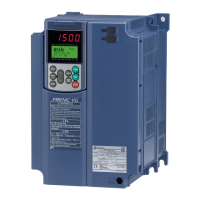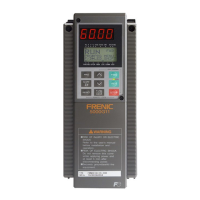5-105
Connect the PTC thermistor as shown below. The voltage obtained by dividing the input voltage on terminal [V2] with
a set of internal resistors is compared with the detection level voltage specified by H27.
H27
[V2]
[13]
0 V
[11]
H26
Motor
PTC
thermistor
Resistor
27kΩ
+10 VDC
<Control circuit>
(Operation level)
External
alarm
Compartor
When using the terminal [V2] for PTC/NTC thermistor input, also turn SW5 on the control printed circuit
board to the PTC/NTC side. For details, refer to Chapter 2, "SPECIFICATIONS."
H28 Droop Control
In a system in which two or more motors drive single machinery, any speed gap between inverter-driven motors results
in some load unbalance between motors. The droop control allows each inverter to drive the motor with the speed droop
characteristics for increasing its load, eliminating such kind of load unbalance.
- Data setting range: -60.0 to 0.0 (Hz), (0.0: Disable)
Select droop control -- DROOP (E01 to E07, data = 76)
This terminal command DROOP is to switch enabling or disabling the droop control.
DROOP Droop control
ON Enable
OFF Disable
To use droop control, be sure to auto-tune the inverter for the motor beforehand.
The droop control under V/f control applies the acceleration/deceleration time to the frequency obtained as a
result of the droop control to prevent the inverter from tripping even at an abrupt change in load. As a result,
reflecting the frequency compensated by the droop control on the motor speed may be delayed due to the
influence of the acceleration/deceleration time specified, which may look as if the droop control is disabled.
By contrast, the vector control without/with speed sensor contains the current control system and the inverter
does not trip even at an abrupt change in load, so the acceleration/deceleration time does not affect the droop
control. It is, therefore, possible to eliminate load unbalance using the droop control even during
accelerating/decelerating.
H30 Communications Link Function (Mode selection) y98 (Bus Link Function, Mode selection)
Using the RS-485 communications link (standard/option) or fieldbus (option) allows you to issue frequency commands
and run commands from a computer or PLC at a remote location, as well as monitor the inverter running information
and the function code data.
H30 and y98 specify the sources of those commands--"inverter itself" or "computers or PLCs via the RS-485
communications link or fieldbus." H30 is for the RS-485 communications link; y98 for the fieldbus.

